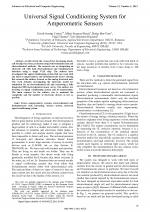| 1/2012 - 4 |
Universal Signal Conditioning System for Amperometric SensorsCRISTEA, D. G. |
| Extra paper information in |
| Click to see author's profile in |
| Download PDF |
Author keywords
amperometric systems, electrochemical and bioluminescent cells, labonchip, sensory system, universal signal conditioning system
References keywords
electrochemical(6), yoav(5), shacham(4), diamand(4), cell(4)
No common words between the references section and the paper title.
About this article
Date of Publication: 2012-02-28
Volume 12, Issue 1, Year 2012, On page(s): 19 - 24
ISSN: 1582-7445, e-ISSN: 1844-7600
Digital Object Identifier: 10.4316/AECE.2012.01004
Web of Science Accession Number: 000301075000004
SCOPUS ID: 84860767531
Abstract
In this article the research for developing whole-cell biochips has been presented using both bioluminescent and electrochemical methods. The research was on integrating an electrode cell with both electrochemical and bioluminescent detection using a single VLSI chip. The authors have investigated the signal conditioning system that can work with any kind of amperometric and bioluminescent sensor. During this research the authors focused on the analog front-end unit. The work includes investigating the electronic model for simulation for an electrochemical cell and conceiving a fully integrated 8X8 electrochemical sensor array. The authors are focusing on signal conditioning system and its functionality. The main concern for the authors was to maintain the complexity and the number of electronic devices as low as possible. |
| References | | | Cited By |
Web of Science® Times Cited: 0
View record in Web of Science® [View]
View Related Records® [View]
Updated 2 days, 2 hours ago
SCOPUS® Times Cited: 0
View record in SCOPUS® [Free preview]
There are no citing papers in the CrossRef Cited-by Linking system.
Disclaimer: All information displayed above was retrieved by using remote connections to respective databases. For the best user experience, we update all data by using background processes, and use caches in order to reduce the load on the servers we retrieve the information from. As we have no control on the availability of the database servers and sometimes the Internet connectivity may be affected, we do not guarantee the information is correct or complete. For the most accurate data, please always consult the database sites directly. Some external links require authentication or an institutional subscription.
Web of Science® is a registered trademark of Clarivate Analytics, Scopus® is a registered trademark of Elsevier B.V., other product names, company names, brand names, trademarks and logos are the property of their respective owners.
Faculty of Electrical Engineering and Computer Science
Stefan cel Mare University of Suceava, Romania
All rights reserved: Advances in Electrical and Computer Engineering is a registered trademark of the Stefan cel Mare University of Suceava. No part of this publication may be reproduced, stored in a retrieval system, photocopied, recorded or archived, without the written permission from the Editor. When authors submit their papers for publication, they agree that the copyright for their article be transferred to the Faculty of Electrical Engineering and Computer Science, Stefan cel Mare University of Suceava, Romania, if and only if the articles are accepted for publication. The copyright covers the exclusive rights to reproduce and distribute the article, including reprints and translations.
Permission for other use: The copyright owner's consent does not extend to copying for general distribution, for promotion, for creating new works, or for resale. Specific written permission must be obtained from the Editor for such copying. Direct linking to files hosted on this website is strictly prohibited.
Disclaimer: Whilst every effort is made by the publishers and editorial board to see that no inaccurate or misleading data, opinions or statements appear in this journal, they wish to make it clear that all information and opinions formulated in the articles, as well as linguistic accuracy, are the sole responsibility of the author.





